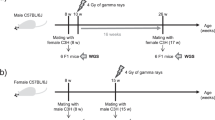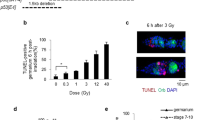Abstract
THE existence of differential radiosensitivity during certain stages of spermatogenesis in Drosophila melanogaster was first proposed by Lüning1. Further evidence provided by Auerbach's2 three-day brood technique suggested that the highest mutation frequency observed in the 3–6-day period following treatment indicated peak sensitivity in immediately post-meiotic stages. Additional support for this view that spermatids were particularly susceptible to the mutagenic action of X-rays was derived principally from the results of irradiating immature sperm in the pupal testis3,4. More definitive daily brood analysis5, however, established a marked dominant lethal frequency ranging over the sixth, seventh and eighth days following the irradiation of newly emerged males, but from these results Bateman was able to draw no firm conclusion other than that this probably represented sensitive meiotic and post-meiotic stages. Using the same technique, Ives6 ascribed the first appearance of induced cross-overs on the seventh day after irradiation to the utilization in this brood of sperm treated in early meiotic and pre-meiotic stages. In a similar experiment, he obtained a maximum frequency of both autosomal recessive and sex-linked recessive lethal mutations on this same day. Sävhagen7 considered sex chromosome loss and non-disjunction also in parallel investigations. Here again, the highest frequencies of X0 males were observed on those days which, by comparison with the non-disjunction experiment, probably corresponded to stages treated before anaphase I of meiosis.
This is a preview of subscription content, access via your institution
Access options
Subscribe to this journal
Receive 51 print issues and online access
$199.00 per year
only $3.90 per issue
Buy this article
- Purchase on Springer Link
- Instant access to full article PDF
Prices may be subject to local taxes which are calculated during checkout
Similar content being viewed by others
References
Lüning, K. G., Hereditas, 38, 91 (1952).
Auerbach, C., Z. indukt. Abstamm. u. Vererbl., 86, 113 (1954).
Khishin, A. F. E., Z. indukt. Abstamm. u. Vererbl., 87, 97 (1955).
Oster, I. I., Proc. Fifth Intern. Conf. Radiobiol., 475 (1956).
Bateman, A. J., J. Genet., 54, 400 (1956).
Ives, P. T., Intern. J. Rad. Biol., 2, 54 (1960).
Sävhagen, R., Hereditas, 46, 651 (1960).
Author information
Authors and Affiliations
Rights and permissions
About this article
Cite this article
STRANGIO, V. Radiosensitive Stages in the Spermatogenesis of Drosophila melanogaster. Nature 192, 781–782 (1961). https://doi.org/10.1038/192781a0
Issue Date:
DOI: https://doi.org/10.1038/192781a0
This article is cited by
-
Studies on the rate of spermatogenesis inDrosophila effects of X-rays and streptonigrin
Zeitschrift für Vererbungslehre (1965)
-
The brood pattern of sensitivity of theDrosophila testis to the mutagenic action of heliotrine
Zeitschrift f?r Vererbungslehre (1963)
Comments
By submitting a comment you agree to abide by our Terms and Community Guidelines. If you find something abusive or that does not comply with our terms or guidelines please flag it as inappropriate.



